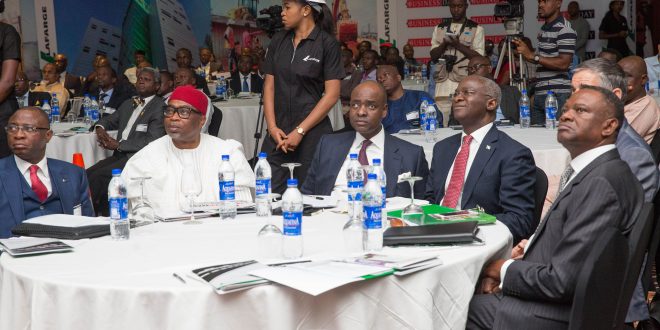 2017 HELD AT THE INTERCONTINENTAL HOTEL, VICTORIA ISLAND, LAGOS ON FRIDAY, 15TH SEPTEMBER 2017
2017 HELD AT THE INTERCONTINENTAL HOTEL, VICTORIA ISLAND, LAGOS ON FRIDAY, 15TH SEPTEMBER 2017
Ladies and Gentlemen:
I welcome the opportunity to speak at this summit and the privilege to deliver the keynote speech, which is one for which I express appreciation to BusinessDay and the sponsors of this summit.
Let me start by saying that this summit coincides with a very important economic matter of public interest which is that Nigeria has broken the cycle of negative GDP growth that characterized a period of recession, and recorded a 0.55% growth that takes her out of recession.
There have been various comments about who and what caused the recession, I think that Nigerians know the answer to that, no matter how vehemently that debate goes on.
All I need to say at this time is that if the previous managers of the economy were doing well, the Nigerian electorate would not have relieved them of their jobs in the last general election; because a recession does not happen overnight.
There have also been questions about what the exit of the recession means to the ordinary Nigerian and this for me is the important question; because, even when the economy was growing at 5%-7%, The complaint was that it was a non-inclusive growth.
Growth was largely oil driven, and sectors like industries, mining and construction had been in the negative since 2014.
There are many reasons for this, not the least of which is the fact that public spending up to 2015 was largely recurrent and minimally capital.
Government was budgeting about 15% of an annual budget of N4 Trillion for capital, which is only about N600 billion, and was funding barely half of that.
If an example is required, it will be found in the 2015 budget, which was the last budget of the previous managers of the economy, where N18 Billion was budgeted for all of Nigeria’s roads, N5 Billion was budgeted for Power and N1.8 Billion was budgeted for Housing.
As if these were not bad enough, barely half of these budget provisions were funded.
The result therefore was that massive debts were owed to contractors who started laying off workers and closing down worksites, and not driving demand for labour, aggregates, lubricants, etc.
The 2016 budget of the Buhari government changed that.
In the Ministry of Power, Works and Housing a total of N422.9 Billion was budgeted, and disaggregated as follows:
- a) Works – 082Billion b) Power – N91.257Billion and
- c) Housing- 559Billion
The total sum of N269.271Billion was paid out to fund this budget and in the final analysis N1.2 Trillion was spent on capital expenditure across all ministries, departments and agencies in the 2016 budget.
Out of these N198.300Billion was spent in the Works Sector on roads and bridges.
This is what induced the recovery of growth and the exit from recession.
It is the exact opposite of what the previous managers of the economy had been doing.
The report of the National Bureau of Statistics clearly makes this connection between infrastructural spending in roads, power, housing, rail when it reads:
“… Q2 2017 GDP results indicate that the recovery was driven by the performance of agriculture and industry, especially crude oil and gas production, as well as…construction…”
“Solid minerals production which had contracted for nine consecutive quarters recorded positive growth of 1.45% in Q2 2017. This represents the first time industry has grown since 2014.”
“In Q1 2017, the solid mineral sector grew significantly by 46% and in Q2 2017 by 2.24 %.”
“In this regard production of limestone, granite and sand accounted for the largest increase in production, accounting for 41.02%, 32.25% and 15.97% respectively, while other minerals account for 10.76%.”
Ladies and gentlemen, let me tie this quickly by pointing out that people do not mine limestone, granite and sand to eat them. These are the essential requirements for construction of roads, raill, bridges and housing projects which this administration embarked upon in execution and implementation of the 2016 budget.
The extraction and movement of these mining products, through drilling, blasting, welding and transportation also drives the demand for lubricants like diesel, grease, engine oil, and fuel like petrol, in addition to the production of bitumen and asphalt, for road surfacing.
This much the NBS report confirmed when it stated that:
“With respect to construction and related activities, GDP in the sector had been negative since Q2 2015, but turned positive for the first time in Q1 2017 growing by 0.15% and continued to positive growth into Q2 2017 by growing by 0.13%. The reversal in construction has to do with civil works especially due to FGN capital expenditure… ”
Ladies and gentlemen, clearly what has worked in other parts of the world is working here.
Infrastructure spend drives the real economy, stimulates production and industrial activity which employs people and includes them.
This is the economics of road construction.
If proof of this is required, I will share some more data.
During the implementation of the 2016 budget we paid:
A. 103 construction companies executing 192 projects were paid who employed 17,749 people directly and 52,000 people indirectly in works.
What this means is that the Economic Recovery and Growth Plan is working. This much the president of the Manufacturers Association attested to when he asserted that this was a plan that had their members input.
It also means that this Government can think through, design and implement a programme to change things for the better.
Has everybody benefited? Certainly not.
So, the growth and exit from recession means that hope has been restored, and if we persevere and persist, the number of people who recovered lost jobs and those who will find new jobs, will gradually increase.
The process to continue this has commenced with the provision of funding under the 2017 budget in the sum of N90 billion.
Out of this:
- N47.169Billion has been paid to 62 contractors working on 149 projects to continue works on roads and bridges and keep people at work and sustain production in works.
Similar payments are being made to supervising consultants and to contractors in Housing and Power Sectors of the Ministry.
With this background, I now go to the innovative side of road construction and economics, and what this government is doing.
We inherited a tax incentive policy for individuals to benefit from tax remission, to recover investment made in public infrastructure like roads, which other members of the public can utilize.
Apart from the fact that pending applications from Dangote group were not approved by the previous managers of the economy, which the present administration has now approved and work has commenced on 42.9 km of the Obajana – Kabba road, this Government has thought it fit to review:
- The five-year limit on that tax order to a ten-year period to sustain private investment in road infrastructure, because it is a long-term asset;
- The order by amending individual investment to include groups of individuals because not all potential investors can individually muster the resources alone but can do so as a group, and recover their pro-rated share;
C. The order by prescribing fast track processes for MDA approvals to prevent a repeat of the 5 years delay that characterized the Dangote application, before this administration finally approved it.
While this is going on, I am pleased to inform you that, we have just concluded an agreement using the tax incentive order to :
- a) Hand over the Apapa area comprising Creek Road, Liverpool Road, Marine Beach to Mile 2, Oshodi, Oworonshoki to the Lagos end of the Toll Gate on the Ibadan Expressway to Dangote Group for construction using concrete on Tuesday, 12th September 2017.
- b) We have also just concluded and signed an agreement with NLNG to construct the Bodo – Bonny Bridge at the cost of N120.6 Billion with NLNG and Federal Government sharing the cost 50-50. The contracts were signed on Wednesday, 13th September 2017.
As for the agreement with Dangote, we are now awaiting the Design of the 35 km stretch excluding the portion that has been completed, about 7 km, by the previous administration around Mile 2 area.
From the design, we will determine the cost and the scope of works which we hope can be executed quickly.
As this Government promised, we will solve the Apapa and Port congestion problem.
I can only tell you that the solution is now on the way.
Ladies and gentlemen, can any well-meaning and right thinking person argue that these are not innovative; or that they will not help road construction?
If you remember, the numbers I have shared earlier about jobs created, and demand for petroleum products and mining products given only by using government funding under the 2016 budget, you’ll see the possibilities that lie ahead and improving those numbers when private capital comes into road construction under the tax relief order as proposed to be amended and complements government spending.
Going forward, we have identified 28 toll plazas out of the old toll plazas, on roads where construction work is currently going on, at which we propose to restore toll plazas.
We have also concluded traffic surveys on 51 major highways and now have current traffic data on these roads and we can project vehicular traffic movement for tolling and concession purposes.
We have concluded preliminary designs for the plazas, and we are now looking at how to incorporate technology such as using contact cards, installing fibre optic, using GSM to enable people pay with minimum use of cash.
The economics of this intervention will bring more demand for services and provide opportunities to build the plazas, manage them, provide telecoms and payment platforms, creating vending opportunities for people to buy their toll tickets in the way they buy their recharge cards.
This is part of what I see ahead.
In addition to these, our roads need traffic signs and road furniture like lane marking and we are working to deploy these very soon across sections of completed roads where we are currently constructing in all the states.
Fabrication of road signs, poles, printing of the lettering and markings will trickle down to small contractors who will be sub-contractors to our main contractors.
These are the economics of road construction, arising from solutions we are developing and deploying which will shortly be felt. It will also provide employment for those who will install the poles, cast the plinth, dig the trenches, install the signs and mark the lanes.
Most of the preparatory work and designs have been done in the Ministry by our staff, working in collaboration with the Federal Road Safety Commission (FRSC), to standardize the signs, the sizes, the lettering, the colour and the dimensions of the poles and the procedure for installation.
Before I conclude, I will move from solutions in road construction to road preservation and maintenance.
Our first strategy is to preserve and prevent abuse to our roads, which are currently being subjected to excessive axle load pressure of overloading.
We are working to install weighbridges at 22 points and 10 points have been completed.
However, the Federal Highways Act prescribes for removal, storage and transhipment of excessive cargo from overloaded vehicles, after they are weighed.
This means that warehouses are required near or at weighbridge locations.
This was not in existence in the past and we have developed strategies to concession these weighbridges to operators who can invest in the construction and operation of warehouses.
We are developing rates and charges for storage that will be applicable per tonnage or other measure of excessive cargo so that the operation is governed by Rules.
We intend to make it cheaper to comply and very expensive to violate our axle load prescriptions.
This is because those who overload their vehicles are making profit at the expense of other road users and diminishing the quality and life expectancy of our roads.
The operation of the weighbridges, the construction of the warehouses, the storage of overloaded cargo, will further enhance economic opportunities for Nigerians from labour, to weighing, use of scales and transport opportunity to tranship excess cargo.
I cannot conclude without speaking about debts owed to state governments and contractors who have invested state funds in Federal roads.
The Buhari administration through an inter-Ministerial Committee chaired by the Ministry of Power, Works and Housing has verified the claims of the debts and the Federal Executive Council has approved a memorandum to pay these debts by the issuance of promissory notes subject to approval by the National Assembly.
The successful implementation of this debt payment solution will release money to states for more road construction, restore confidence in the construction industry who can only then do more to stimulate production demand and economic growth.
Ladies and Gentlemen, these are my thoughts about the economics of innovative solutions to road construction in Nigeria.
They portend enormous possibilities ahead if we all play our roles to build on the hope that comes on the exit of our economy from recession.
The results will not happen instantly, they will take time, they will require us to continue to build our roads metre by metre, day by day because road map and the destination I have laid out is clear enough to right thinking and well-meaning Nigerians.
Thank you very much for your attention.
Babatunde Raji Fashola, SAN
Honourable Minister of Power, Works and Housing
 Hottestgistnaija.com
Hottestgistnaija.com





